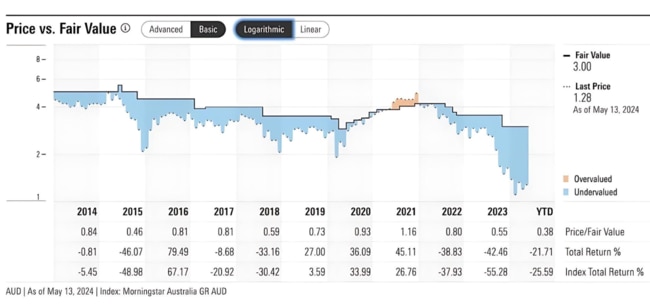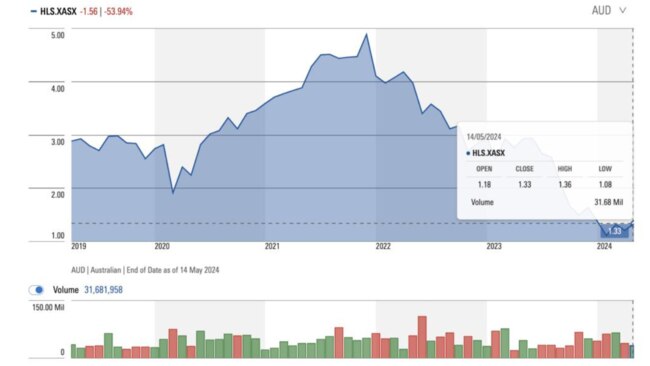Blood is thicker this quarter: Part 2. Healius
In Part 2 of our look at the ASX’s dominant pathology stocks, Morningstar considers the second-largest operation, Healius and areas it can finetune.

Welcome to part 2 of Stockhead’s examination of Aussie pathology companies. Well, really, it’s Morningstar’s assessment, brought to you by us. Apologies if you read Part 1 -focusing on Sonic Healthcare – and find some the next few bits repetitive. You see we can’t assume you saw that.
The biomedical treatment of disease and injury is what we call pathology.
Needles. Blood. Tissue. Other gross things. Etc.
From the commonplace lab services which take and test our blood, to the cutting edge biological research of medical innovation, jabbing everyone with syringes is merely the tip of the haemagloberg.
And while all pathologists undoubtedly look back at 2020-22 with a wistful sigh of Covid-longing, for these major ASX-listed bloodsuckers, the pandemic was a Cambrian-like explosion of activity which has left a void that’s been hard to fill.
For the latest health news, sign up here for free Stockhead daily newsletters
Shares in Sonic Healthcare (ASX:SHL), Healius (ASX:HLS), and Australian Clinical Labs (ASX:ACL) have fallen by roughly 60 per cent on average since the start of 2022.
And, according to the fastidiously nocturnal studies of ageless Morningstar equity analyst Shane Ponraj, each stock now trades at an average 35 per cent discount to Morningstar’s fair value estimates which look thusly:
- SHL – $32
- HLS – $3
- ACL – $3.50
Ergo sum: Australia’s top pathology providers are significantly undervalued.
In this Part 2 of our bloody-minded three-part Stockhead special, Ponraj extracts, dissects and analyses Helius across the full spectrum of its business.
Within the broader ASX healthcare sector, Ponraj says pathology stocks screen attractively.
The rather niche subsector trades at an average price/fair value estimate of 0.65 versus the healthcare sector average of 1.11.
That means there’s a lot of room to grow.
Ponraj said the joys of higher-for-longer elevated margins during coronavirus testing were never going to last forever, no matter how it might’ve seemed at the time.
And in the intervening few years it appeared traders had new and more timely narratives, so pathology providers fell out of favour with the market, and margins were now below pre-pandemic levels.
While the market doubts a return to pre-pandemic profitability, Ponraj said he saw several reasons to expect a stronger recovery than market consensus – increased pricing, stabilising costs, and scale benefits.
“Our fiscal 2028 operating margin forecasts for Sonic, Healius, and Australian Clinical Labs are 14 per cent, 12 per cent, and 11 per cent, respectively, versus operating margins of 12 per cent, 8 per cent, and 4 per cent in fiscal 2020 before material coronavirus earnings,” he said.
Bloody dominant
Ponraj said the three main pathology providers, with more than 80 per cent combined market share, were well-positioned to benefit from industry trends.
And long-term volume growth drivers were intact.
“In the near term, we expect elevated volume growth as patients return to routine diagnostic testing and general practitioner attendances recover on new bulk billing incentives,” he said.
“We forecast a five-year revenue compound annual growth rate of 5 per cent for the pathology industry, with roughly two-thirds from expected volume growth and the rest from pricing.
“Demand is driven by population growth, ageing demographics, higher incidence of diseases, wider adoption, and a higher number of tests available.”
MORE FROM STOCKHEAD: Budget boost for HIV test kit maker | ASX biotechs catching experts’ eyes, Part 1 | Part 2
So, what’s the score with Helius?
Healius is the second-largest pathology operator in Australia and third-largest diagnostic imaging provider.
HLS told the ASX this week that it had successfully refinanced Tranche A of its syndicated debt facility with the support of lenders until March 2027.
At December, Healius had $327 million of net debt, which was 3.17 times its earnings, below its covenant of less than four times.
But it had reduced the level through a capital raising, after it was $447 million in the 2023 financial year.
Its banking facilities had been reduced by $250 million to $750 million and it was reviewing asset sales as part of its capital management focus.
Pathology and imaging revenue is almost entirely earned via the public health Medicare system.
Healius typically earns approximately 75 per cent of revenue from pathology and 25 per cent from diagnostic imaging.
As part of the refinancing, Healius has scaled back both demand and the size of the tranche from $250 million to $180 million, while ensuring sufficient headroom and liquidity for its operations.
Despite Healius operating roughly one-third of Australia’s collection centres, slightly ahead of Sonic’s share, its pathology business is significantly smaller.
“This suggests Healius’ network is less efficient, with collection centres likely being smaller on average and in less populous locations,” Ponraj said.
For example, while Sonic operates the majority of centres in the most populous state, New South Wales, Healius claims the majority in the least dense, Northern Territory.
Location, Ponraj says, is key as patients tend to submit test samples at a convenient pathology lab and doctors are unable to specify the lab unless there is a medical reason to do so.
“This poses a significant structural challenge for Healius to gain throughput efficiently and generate economic profits,” he said.
“Its weaker competitive position in the Australian pathology market is also highlighted by Healius’ trailing three-year organic revenue CAGR of 3.8 per cent to fiscal 2020 versus Sonic’s 5.3 per cent and market growth of 4.7 per cent.”
Strategic growth
In 2018, the former Primary Healthcare rebranded itself as Healius.
Ponraj said that today, Healius was looking to new sources of strategic growth, as well as dealing with prior under-investment in infrastructure.
“There is much to fix in the business and we anticipate it to take a few years before significant margin improvements are made in the base pathology and imaging businesses,” he said.
“Healius selling its medical centres and Montserrat day hospitals to focus on redirecting capital toward infrastructure upgrades and its diagnostic businesses is viewed as a positive strategic step.”
Ponraj said the key was improvement in systems to lift efficiency.
“Pathology is an increasingly technologically driven service and the company intends to invest in a new laboratory information system, automation, and digitisation through to fiscal 2024,” he said.
“However, while we view the system upgrades as necessary to restore earnings growth, we don’t see the company building an advantage over rival Sonic Healthcare, which is also continuously improving its systems.”
Virtually all revenue is earned directly from Medicare via bulk-billing in the pathology and imaging segments.
“Healius’ organic volume growth in its core pathology segment has typically ranged between 3 per cent and 5 per cent and we forecast a similar rate over our 10-year forecast period,” Ponraj said.
Visit Stockhead, where ASX small caps are big deals
He said the volume growth was underpinned by population growth, ageing demographics, higher incidence of diseases, and wider adoption of preventive diagnostics to manage healthcare costs. In addition, the number of tests available was expanding.
Ponraj also said that although Healius enjoyed sizeable market shares in Australian pathology and diagnostic imaging, its inability to set prices and weaker market position relative to Sonic Healthcare prevented it from digging an “economic moat” sourced from cost advantages.
“Revenue in pathology and imaging is earned via direct reimbursement from Medicare at fixed fee per service rates,” he said. “Healius neither currently earns a return on invested capital above its cost of capital, nor do we expect it to in a typical year over our forecast period.
“We include goodwill and intangibles in the invested capital base, which arose from acquiring independent practices and the upfront sign-on payments to attract healthcare professionals.”
Healius is looking to reinvest in its business to upgrade its ageing lab information systems, IT infrastructure, and automation, Ponraj says.
“While we expect this to narrow its relative technological disadvantages, and the returns on this reinvestment could be very high, we forecast Sonic to maintain a significant cost advantage derived from its superior and growing scale.
“Healius may also remain the laggard as Sonic simultaneously continues to upgrade its systems.”
Fair value
Morningstar’s $3 fair value estimate for Healius (versus $1.28 at 1pm Thursday, AEST) factors in 5 per cent group revenue growth in a typical year and a mid-cycle operating margin of 14 per cent.

“Our estimates deliver EPS growth of roughly 10 per cent in a typical year,” Ponraj said.
“The pathology segment is the primary earnings driver. We forecast a 10-year pathology revenue CAGR of 4 per cent and expect segment EBIT margins to expand to 14 per cent by fiscal 2033 from 1 per cent in first-half fiscal 2024 on operating leverage, improved mix, and productivity improvements.
“Our 4 per cent revenue CAGR is made up of 3 per cent volume growth due to population factors and volume growth per capita and 1 per cent average fee increases due to a mix shift to more complex tests such as veterinary and gene-testing. We do not factor in reimbursement pricing pressure in our base case.”
Morningstar’s forecast for diagnostic imaging revenue is to increase at a 7 per cent CAGR over the 10 years to fiscal 2033 from a combination of organic volume growth and indexation of fees.
“We forecast EBIT margins to expand to 14 per cent by fiscal 2033 from 8 per cent in first-half fiscal 2024 through network optimisation, customer digitisation and exposure to higher-margin imaging modalities increasing.”

Risk and uncertainty
“Despite the relatively predictable nature of its revenue growth drivers in the base business and the industry being defensive, there remains some uncertainty surrounding the success of Healius’ turnaround efforts and how much coronavirus testing will persist at a base level – notwithstanding the ongoing threat of new contagious strains,” Ponraj said.
“Given Healius’ high operating leverage, margins are sensitive to test volumes, and system upgrades may fall short of productivity improvement targets.
“Due to volume rather than price being the main revenue driver across Healius’ divisions, productivity improvements are critical.
“Historical margin declines in the core pathology segment illustrates that the company has been challenged and needed to invest with productivity and cost savings in mind.
“Reimbursement pressure is less of a concern.
“We expect little change in the regulatory environment with inflationary fee increases also recommencing in diagnostic imaging in fiscal 2021.
“The primary ESG risk is related to product governance, where a major failure in lab technology or improper tests lead to a large increase in misdiagnoses.
“Lab results are critical in making decisions about appropriate treatment and surgery, and a serious systematic failure may expose Healius to patient liability claims and contract losses.
“However, given Healius’ proven track record in overseeing its operations with well-established processes, we do not think this is likely or would lead to material value destruction.
“Healius’ processing, collection, and storage of large amounts of sensitive patient data introduces another ESG risk.
“Failure to secure and protect private data from theft or misuse could lead to patient liability claims and reputational damage. However, we think one-off fines or extra compliance costs would be immaterial, and reputational damage is limited given that Healius operates under numerous brands.”
Capital allocation
Healius’ balance sheet is in sound condition after the sale of its medical centres, Ponraj says and financial risk is slight given low revenue cyclicality and solid cash conversion.
“Assuming no significant acquisitions, we forecast the company to be in a net cash position for most of our 10-year explicit forecast period, while also funding its organic growth and maintaining a 60 per cent dividend payout ratio.
“Healius has suffered from under-investment in the past but we think simplifying the business by selling its medical centres and Montserrat day hospitals and redirecting capital toward much needed infrastructure upgrades is strategically sound.
“We expect returns on invested capital to improve but typically remain below the company’s 8.5 per cent weighted average cost of capital over our ten-year forecast period.
“As Healius has a history of making acquisitions, we include goodwill in our invested capital base.
However, shareholder distributions are mixed.
“While we think the current target 50 per cent to 70 per cent dividend payout ratio of earnings is appropriate to fund its planned reinvestment, its 2021 share buyback program was dilutive with shares repurchased at an average execution price of $4.47, roughly a 6 per cent premium to our fair value estimate.”
This content first appeared on stockhead.com.au
The views, information, or opinions expressed in the interviews in this article are solely those of the interviewees and do not represent the views of Stockhead. Stockhead does not provide, endorse or otherwise assume responsibility for any financial product advice contained in this article.
SUBSCRIBE
Get the latest Stockhead news delivered free to your inbox. Click here


